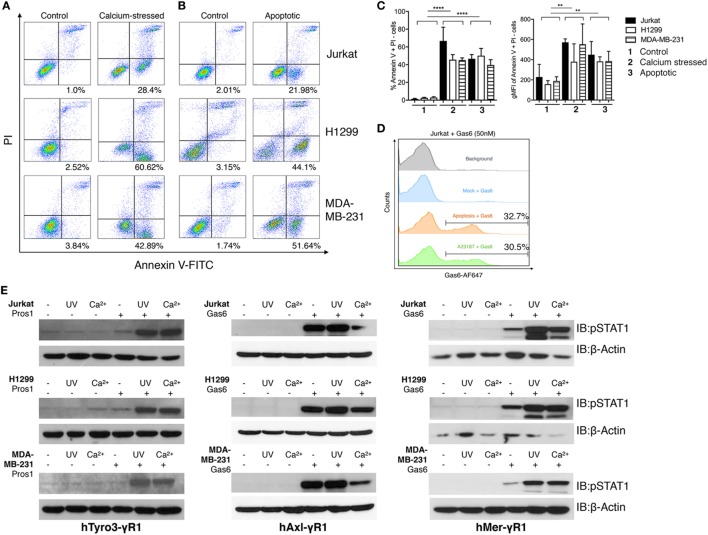Figure 4.
Phosphatidylserine (PS)-positive apoptotic and calcium-stressed cells differentially affect Tyro3, Axl, and Mertk (TAMs) activation by growth arrest-specific 6 (Gas6) or protein S (Pros1). (A) Jurkat, H1299, and MDA-MB231 cells (top to bottom) were treated with calcium ionophore A23187 (10 μM) for 15 min in 37°C and then stained with FITC-Annexin V and PI to assess PS externalization. (B) Jurkat, H1299, and MDA-MB231 cells (top to bottom) were treated with UV radiation and then stained with FITC-Annexin V and PI to assess PS externalization. (C) Percentage (left) and MFI (right) quantification of the Annexin V+/PI− cells that were induced by calcium stress or UV radiation from independent experiments (n = 3). Error bar, SEM, **p < 0.005, ****p < 0.0001. (D) Recombinant Gas6 protein at concentration of 50 nM was added to 1.0 × 106 apoptotic or calcium-stressed Jurkat cells and subsequently stained with anti-hGas6 primary and antirabbit Alexa Fluor 647 secondary antibody to assess Gas6-cell surface association by flow cytometry. Background (gray): Jurkat cells without treatment were stained with primary and secondary antibodies; Mock + Gas6 (blue): Jurkat cells without treatment were incubated with 50 nM Gas6 and then stained with primary and secondary antibodies. (E) Three modes (resting, calcium-stressed and apoptotic) of Jurkat, H1299 and MDA-MB231 cells were mixed with Gas6-containing media (Gas6-CM, Gas6 concentration estimated as 250 nM) or Pros1 (100 nM) to stimulate hTAM/IFNγR1 reporter cells. The activation of TAM receptors was assessed by pSTAT1 immunoblotting. The Western blotting results are representative results from at least three independent experiments.

